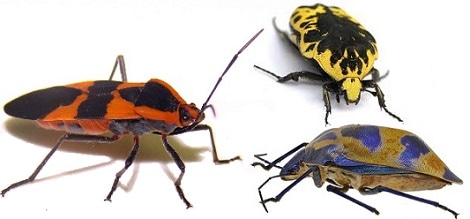Harlequin Bug Habits and Identification
The Harlequin bug is a variety of stink bug and not a true beetle. The adult black, shield-shaped bug is covered with orange, red, and yellow markings. It varies in size, but is generally no more than 3/8 inch.

The barrel-shaped egg, laid in clusters on crucifer foliage, is light gray to pale yellow with two black bands . The nymph is similar to the adult in coloration, but is smaller and lacks wings.
The Harlequin bug ranges from Atlantic to Pacific and Southern Canada to Northern Mexico. It does its primary damage in warmer regions. They will feast on squash, corn, bean, asparagus, okra, tomato, cabbage turnip ,Brussels sprouts, cauliflower, cabbage, kale, kohlrabi, lettuce, collard, mustard, radish.
Damage to Plants
Both adults and nymphs eat all parts of the plant and will cause plant damage. They have piercing mouth parts which they use to suck out plant juices. Damage on foliage and stems appear as uneven discolored spots around a central hole . Weak and Young plants wilt, brown, and die off.
Healthy mature plants generally survive but growth and production is retarded.
Damage on fruits appear as dark holes surrounded by a pitted surface and white to pale yellow spots. These spots do not ripen correctly . Fruits may also show blemishes and grow into unusual shapes.
Harlequin Bug Life Stages
Harlequin Bug adults over winter in dormant plants and garden debris. They emerge in the early spring and begin feeding and laying eggs. Harlequin Bug eggs take up to 3 weeks to hatch, in warmer climates they can hatch in 5 days. Nymphs will mature into adults in about 6 weeks. Populations climb as the season progresses, getting heaviest during early to mid fall. There are up to 4 generations annually.
Handpicking is not always feasible in larger gardens. In small gardens, handpicking is somewhat helpful. Destroy adults and larvae, New adults may eventually migrate to your garden, so be sure to check your plants on a regular basis. Harlequin Bugs stink when you squash them, they are a type of stink bug, it might be easier to just drop them into a pail of soapy water.
Prevention and Control
Grow resistant varieties. Some types of brassica plants have a natural resistance to Harlequin bugs. This information is generally available from the seed suppliers.
Till the ground in late Autumn. Tilling crop leftovers into the soil once cold weather sets in can will reduce the number of adult Harlequin Bugs who will survive winter, as well as other garden pests.
Weed Control . Harlequin Bugs, like many other insects are attracted to weedy areas in the gardens vicinity. Weeds should never be permitted to spread in the garden area. Weeded areas in the gardens vicinity should be mowed down before the spring planting and maintained that way throughout the season.
Minute pirate bugs will eat stink bug eggs and nymphs, and Praying Mantids will attack adults. Lady Bugs are somewhat helpful against the nymph and egg stages only.
You might also choose to apply an organically acceptable insecticide, such as rotenone, pyrethrin, Neem oil, or insecticidal soap.
Bacillius thuringiensis [Bt] is highly effective against the larvae stage and should be applied as soon as the larvae are first noticed or suspected.
Azatin or Azadirachtin aka Neem Oil, prevents the larvae from developing normally and is also a good alternative for later larval stages. These products degenerate rapidly in nature and need to be reapplied frequently
Pyola is an effective alternative to chemicals. Made from canola oil and pyrethrins, pyola controls many stubborn insects. The use of synthetic insecticides is not recommended.
Esfenvalerate, a fairly new non organic insecticide is sometimes used, resistance is not well established. It is also pyrethin based.
Spinosad, an organic pesticide, is based on a bacterium ‘Saccharopolyspora spinosa’ , which was discovered in an old Caribbean rum still. It was discovered that these bacteria produce a substance that works as a neurotoxin in many insects. Susceptible insect species exposed to spinosad become ‘intoxicated’, stop eating immediately, and die within days.

